Content
- Views
- Right-sided curvature
- Left-sided curvature
- Classification by the affected area
- Stages and degrees
- First degree
- Second degree
- Third degree
- Fourth degree
- Symptoms and Signs
- Causes
- Diagnostics
- Treatment methods
- Wearing a corset
- Physiotherapy
- Physiotherapy exercises for scoliosis
- Possible consequences and complications
- Scoliosis video
Lateral curvature of the spine or whatever in medicine it is called scoliosis - This is a progressive disease that is severe. It is characterized by a curvature in the form of an arc in the frontal plane and twisting of the vertebrae around the vertical axis. The disease is caused by pathological changes in the spinal column and paravertebral tissues.
If you do not stop the development of the disease, then it will actively develop, provoking secondary deformation of the chest, pelvis and some internal organs. A specialist can diagnose an ailment after examination or passing an X-ray.
Views
Lateral curvature or scoliosis is of two types: structural or non-structural. The latter type provides for less pronounced changes - the patient has a lateral curvature without persistent twisting of the vertebrae.

The disease is also classified according to the direction of the curvature.
Right-sided curvature
In most patients who have consulted an orthopedist, it is often the lateral curvature of the spinal column that is observed. This diagnosis is diagnosed in 70% of people. Due to the fact that the spine is bent to the right, the functions of internal organs are disrupted, especially the respiratory, heart and blood vessels.
Left-sided curvature
This type is diagnosed much less often than right-sided. More often women are diagnosed. The ailment proceeds almost without symptoms, so it can be detected only with a planned visit to an orthopedist or undergoing instrumental diagnostics.
Classification by the affected area
In orthopedics, scoliosis is also classified depending on the zone of curvature of the spine.
The affected area can be determined according to the symptoms that appear, as well as the nature of the complications that arise:
- Cervico-thoracic region. With this shape, the curvature arcs are localized in the region of 4-5 vertebrae of the thoracic region with extension to the neck region. As the progression progresses, the arch appears in the lumbosacral region.
-
Chest. The curvature is localized in the region of the 7-8 vertebra. This form is more common in people with right-sided curvature. The disease progresses rapidly, which ultimately leads to disability.
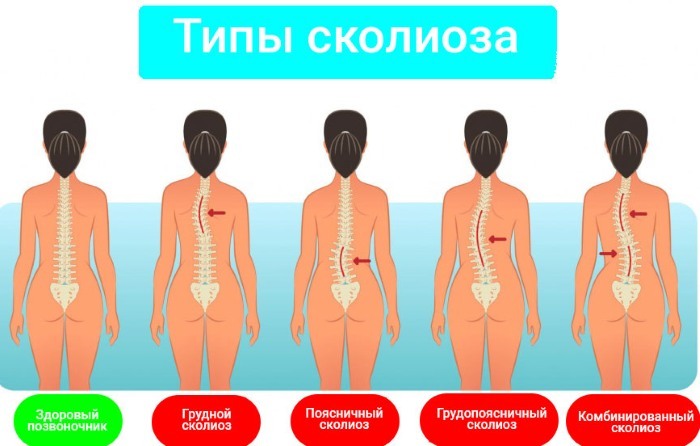
- Lumbar-thoracic. The curvature is observed in the area of the 10-12 vertebra. Right-sided scoliosis develops much faster than left-sided, and the symptoms differ only in the intensity of manifestations.
- Lumbar. The curvature arc is localized in the zone of 1-2 vertebrae of the lumbar spine. More often this form manifests itself in patients with left-sided scoliosis. The main difference between this ailment is that in rare cases, a strong curvature occurs. Even 2 stages of the disease can be detected on an X-ray.
- Lumbosacral. This form is very rare. The curvature arch is localized in the lower part of the lumbar vertebrae.
Stages and degrees
To establish the correct degree of curvature, you need to measure the angle of deviation of the spinal column from the norms. Measurements are carried out after receiving an X-ray image on the hands.
First degree
Lateral curvature of the spine with a deviation from the norm of no more than 10 degrees is the first stage of scoliosis, which does not manifest itself outwardly.
You can independently determine this degree by the following criteria:
- slight stoop;
- shoulders are brought together;
- slight asymmetry of the shoulders;
- asymmetrical waist;
- rotation of the vertebrae around the axis;
- the head is slightly lowered.
Second degree
The axis is deviated from the norm within the range of 11-25 degrees. With this degree of scoliosis, the curvature of the spinal column is slightly more pronounced, there is slight twisting, and there is deformation of the vertebrae at the apex of the arch. Also, the patient has a rib hump, which is poorly expressed.
Third degree
Deviation from the axis is already observed by more than 26 degrees, the patient has severe deformities and torsion of the vertebrae, there is a pain syndrome that requires the use of anesthetics.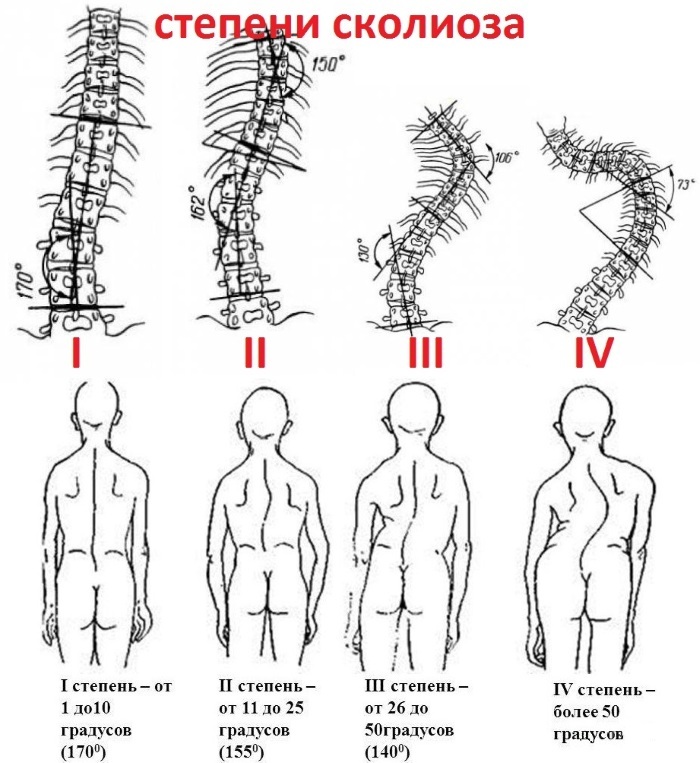
Other signs are also observed:
- rib hump is pronounced;
- sinking of the ribs;
- the arches of the ribs protrude significantly from the front;
- abdominal muscles are weak.
Fourth degree
The angle of deviation from the norm is already more than 50 degrees, the deformations are already much more pronounced, the internal organs, especially those that are localized in the chest area, work with serious failures. The patient is severely tormented by back pain. The muscles in the area of the curvature of the spine are strongly stretched, there is a retraction of the ribs.
Symptoms and Signs
Lateral curvature of the spine is an ailment that is difficult to diagnose at the initial stage. At the first stage, there are no tangible signs of the disease. It is possible to make a diagnosis at the initial stage only if you regularly undergo an examination by an orthopedist and take an x-ray.
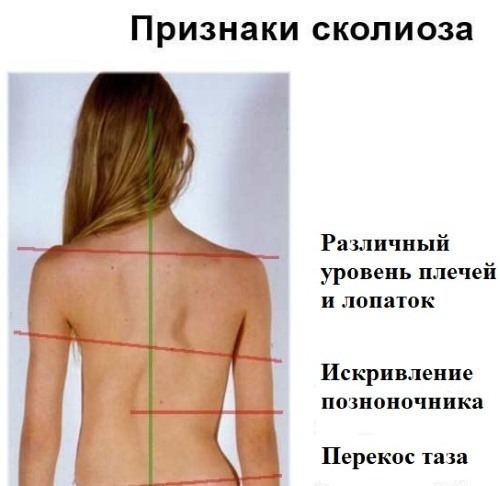
If the disease progresses, then with the naked eye, changes are noticeable, manifested in the form of an uneven position of the shoulders, a displacement of the waist line, and a bulging of one of the shoulder blades. If the ailment is already in an advanced form, then severe pain informs the patient about it. After a serious deformity of the spinal column, the patient has a strong bulging of the ribs on one side.
Causes
Lateral curvature of the spine is a serious condition that can occur in people of all ages for a variety of reasons.
| Congenital | A newborn is born already with anomalies in the development of the spinal column: asymmetric fusion, transverse processes and others. |
| Neuromuscular | Weakness and lack of development of muscles and ligaments in the spine, congenital low muscle tone, myopathy, cerebral palsy, multiple sclerosis and others. |
| Syndrome-related | This form develops against the background of connective tissue dysplasia in the presence of diseases such as Marfan or Ellers-Danlos syndrome. |
| Idiopathic | Until now, the true causes of development have not been clarified. |
| Secondary | Developed after injuries, spine and chest surgery. |
Diagnostics
Lateral curvature of the spine is a serious ailment that is treated by orthopedists and vertebrologists. If there is discomfort in the back, then you need to contact your family doctor. He will prescribe a comprehensive examination, which will include X-ray.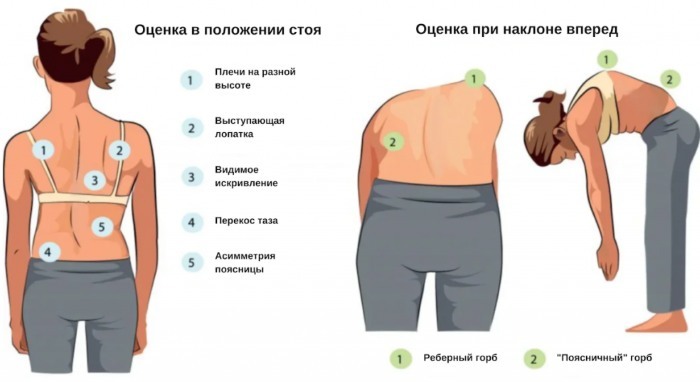
To make an accurate diagnosis, it is carried out:
- Visual examination of the patient. The disease can be identified by the asymmetry of the back. There is a shift in relation to the midline of the body. Shoulders and shoulder blades are not at the same height. The specialist conducts the examination in several positions: standing, sitting and lying.
- X-ray. This method is considered the most effective when diagnosing scoliosis. With its help, you can establish the severity of the disease, how mature the frame is, and also determine the disease is congenital or acquired. The picture is taken in two versions: lumbar and thoracic, in the forward direction and from the side. You can take the examination at the clinic for free.
- Optical tomography on a computer. This study involves projecting vertical stripes onto the patient's back, which ideally follow all the curves of the body. The projection is transferred to the computer screen, where the received data is processed. This technique is rarely used, it is harmless, but its cost is not affordable for everyone. The price varies from 1000 rubles.
- MRI. This technique is used not for making a diagnosis, but for an examination that allows you to identify a curvature that is already there. It is recommended to carry it out before the operation, because it can be used to assess the condition of the bone tissue, to identify the presence of hernias, tumors. The study can be done in special clinics, and it will cost an average of 3000 rubles.
- Cobb's technique. It helps to accurately determine the angle of scoliosis. This technique involves the passage of an X-ray, and after that it is possible to determine from it where the arc is and how much it is curved.
- CT. This technique helps to identify pathologies of bone tissue, but soft tissues are poorly reflected in the image. The cost of the examination varies within 1500 rubles.
Treatment methods
Lateral curvature of the spine is an ailment that requires timely and comprehensive therapy. Treatment is aimed at removing the cause provoking the curvature of the column, returning it to a physiological position, and stopping the progression.
To remove the symptoms, they prescribe the use of analgesics, and in some cases, they may be recommended for taking. muscle relaxants and drugs, the action of which is aimed at improving blood microcirculation at the site of localization of changes in spine.
Wearing a corset
Children during their active growth, when there are signs of incipient scoliosis, are advised to wear a corset. Wearing it helps to correctly distribute the load on all parts of the spine, as well as significantly reduce the pathological mobility of the spine. The choice of a corset model should be made by a specialist, since it is necessary to take into account the location of the curvature localization.
Physiotherapy
With the help of physiotherapy, it is possible to restore metabolic processes in the body, increases blood flow at the site of tissue damage, eliminates pain and signs of an inflammatory process. Such therapy helps to correctly distribute the load on all parts of the spine and muscles. Scoliosis forces one part of the back to be constantly in strong tension, but the other part, on the contrary, weakens.
With scoliosis, a specialist may prescribe the following procedures:
-
Massage. It helps to normalize the work of the back muscles, relieves pain perfectly. During the procedure, all parts of the spine are worked out; it can cause some discomfort.

- Electrophoresis. This method is considered helper. It is used to relieve spasm, which is always present in diseases affecting the musculoskeletal system. The technique allows for the passage of drugs into the deep layers of the epidermis.
- Heat therapy. For curvature of the spine, thermal treatment involves the use of artificial or natural sources of heat. The procedure can be dry or wet. Heat therapy helps to restore the outflow of lymph and blood, stimulates regeneration processes, removes products formed as a result of tissue decay.
- Mud therapy. Therapeutic mud helps to normalize muscle tone, restore nerve conduction in the affected area of the spine. The increased blood flow helps speed up the healing process.
Physiotherapy exercises for scoliosis
With scoliosis, physiotherapy exercises are invaluable.
With its help you can:
- restore muscle tone;
- normalize blood flow at the site of the lesion of the spinal column;
- the angle of curvature is significantly reduced;
- pain syndrome goes away.
Exercises are selected depending on the type of scoliosis.
It is also important to familiarize yourself with some of the rules before starting the use of physiotherapy exercises:
- exclude all exercises that can worsen the condition of the spinal column, these include: hanging on a horizontal bar, lifting weights, jumping, running;
- the first classes should take place at a calm pace;
- the number of approaches and the difficulty of the exercise should increase gradually;
- traction of the spine is allowed only passive.
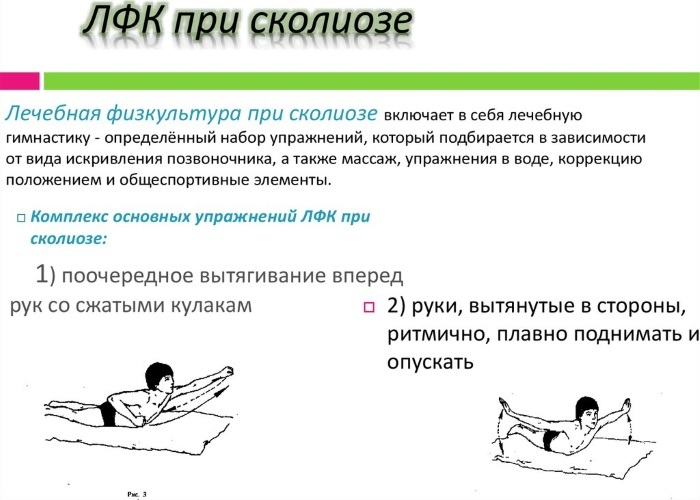
The warm-up should start with a warm-up:
- Stand with your back to the wall so that the heels touch it, as well as the buttocks, shins and the back of the head. Fix the case in this state and move away from the wall.
- Spread your legs a little, raise your straight arms up and slightly take them back through the sides. Repeat rotation several times.
- Step lightly in place, without raising your knees too high, while your hands should rise up as you inhale, and descend as you exhale.
The main complex for thoracic scoliosis consists of the following exercises:
- Take the position of a hedgehog on the back, bend one leg at the knee and pull it to the chin, rounding the back. Repeat with the other leg.
- Lying on your back, bend your knees. Raise the body so that the supports only touch the feet, shoulder blades and shoulders.
- Lie on your stomach, rise on your hands so that the upper part of the body rises above the floor, and a deflection forms in the place of curvature of the spine.
If the curvature is found in the lumbar region, then you can perform the following exercises:
- Take a sitting position, throw your hands behind your head, placing your palms on the back of your head. Perform several lifts to the site of curvature of the spine.
- Take a supine position, raise straight legs and simulate cycling.
- Lie on your side so that the outside of the arc of curvature looks up. Put one hand under the head, and the other under the body. Raise your legs at an angle of 30 degrees.
Asymmetrical exercises will help put stress on the outside of the curvature.
They should be performed as follows:
- Lie on your back, perform a deflection in the chest area, the arm, which is located on the inside of the arch, should be extended forward.
- Standing on the floor, take your hand back from the outside of the deflection, and raise the other up.
- Lie on your side on the inner side of the arc, lift the body.
At the end of each workout, which should be carried out daily, it is imperative to do reinforcement. It can help relax muscles and help the body recover from exercise faster. It is enough just to walk in place, while you can periodically stand on your toes, while raising your hands up. You can also walk in place, raising your knees high up as high as possible.
At the initial stage, gymnastics is performed until the patient feels tired, there is no need to immediately overload the body. After 1-2 weeks, you can increase the number of approaches by increasing the load. If any exercise is uncomfortable, it should not be done.
Possible consequences and complications
If you do not identify the disease in time and do not start timely treatment, then the consequences can be much more severe than it might seem. Complications can be associated with a physiological deterioration in health, as well as have a psychological character. Orthopedists advise everyone, without exception, to react to any changes in posture in order to have time to prevent complications.
Scoliosis provokes a turn and displacement of the vertebrae. Normally, the spinal column itself is quite active, and the space between the vertebrae is filled with discs and cartilage. With scoliosis, the vertebrae come close to one another, which can provoke pinching of the nerve endings.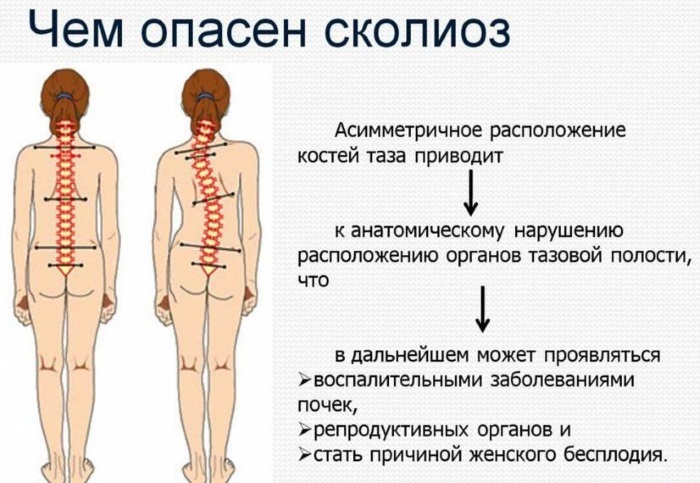
If small branches are affected, then a slight tingling sensation is observed in the limbs. But the most dangerous is the pinching of the spinal cord. With this complication, paralysis of the lower extremities is observed and, as a result, paralysis. It is no longer possible to cure this condition.
Scoliosis is often diagnosed in children and adolescents. It provokes asymmetry of the shoulders, pelvis, curvature of posture and the appearance of a hump. Such symptoms lead to the fact that the child cannot feel confident in the circle of peers. If you do not start treatment, then the teenager can withdraw into himself and become an indecisive person in the future.
Lateral curvature of the spine or scoliosis is a pathology that requires timely diagnosis and complex therapy. Identifying the disease at an early stage helps to get rid of symptoms without consequences and complications. If the first unpleasant signals appear in the back, it is better to seek advice from an orthopedist. It has been known for a long time that any ailment is much easier to prevent than to cure in the future.
Scoliosis video
Symptoms of scoliosis at different stages:
